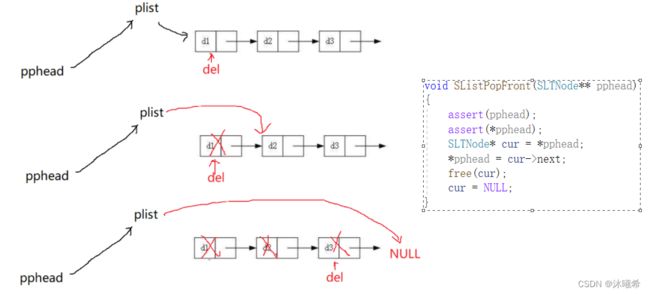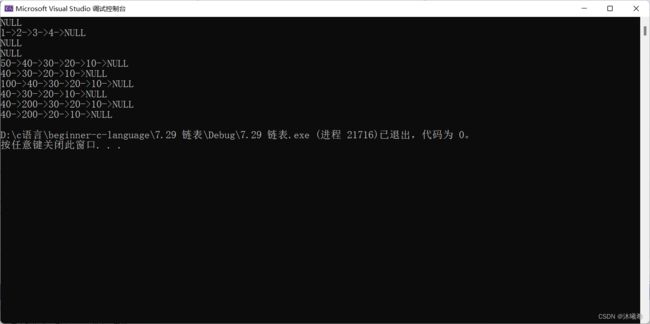【数据结构初阶】线性表——单链表(手撕单链表)
大家好我是沐曦希
链表
- 1.链表的概念及结构
- 2.链表的分类
- 3.单链表的实现
-
- SList.h
- SList.c
- test.c
- 4.单链表改进
-
- 4.1 替换法删除pos
- 4.2 替换法pos之前插入节点
- 5.写在最后
1.链表的概念及结构
概念:链表是一种物理存储结构上非连续、非顺序的存储结构,数据元素的逻辑顺序是通过链表中的指针链接次序实现的 。
链表逻辑的结构(形象化):
物理结构(在内存中时间存储结构):
2.链表的分类
实际中链表的结构非常多样,以下情况组合起来就有8种链表结构:
- 无头单向非循环链表:结构简单,一般不会单独用来存数据。实际中更多是作为其他数据结构的子结构,如哈希桶、图的邻接表等等。另外这种结构在笔试面试中出现很多。
- 带头双向循环链表:结构最复杂,一般用在单独存储数据。实际中使用的链表数据结构,都是带头双向循环链表。另外这个结构虽然结构复杂,但是使用代码实现以后会发现结构会带来很多优势,实现反而简单了。
3.单链表的实现
SList.h
#pragma once
#define _CRT_SECURE_NO_WARNINGS 1
#include要更改头结构体指针plist时,应该进行传址调用,所以用二级指针来接受。
改谁用谁的指针。
在很多库里面都会分别有在pos前后插入x的函数和分别有删除pos位置和删除pos位置之后的值的。
// 单链表在pos位置之前插入x
void SListInsert(SLTNode** pphead, SLTNode* pos, SLTDataType x);
// 单链表删除pos位置
void SListErase(SLTNode** pphead, SLTNode* pos);
// 单链表在pos位置之后插入x
void SListInsertAfter(SLTNode* pos, SLTDataType x);
// 单链表删除pos位置之后的值
void SListEraseAfter(SLTNode* pos);
区别在于:
1.在pos前插入x和删除pos位置的函数声明要传单链表的头结构体指针。
在pos前插入x时,当pos为第一个节点时,要改变头结构体指针的指向新的节点,就要传头结构体指针的地址。头结构体指针指向新的节点,新的节点的next指针指向第一个节点或者NULL。

删除pos位置的值时,当pos为第一个节点时,要改变头结构体指针的指向新的节点,就要传头结构体指针的地址。头结构体指针应该指向第二个节点或者NULL。

2.在pos前插入x和删除pos位置的实现要进行分情况讨论,
即第一种情况为pos为第一个节点和第二种情况pos不为第一个节点,代码更为复杂。
SList.c
要更改头结构体指针plist时,应该进行传址调用,所以用二级指针来接受。
改谁用谁的指针,并且传的是头节点指针的地址。
#include"SList.h"
void SListPrint(SLTNode* phead)
{
SLTNode* cur = phead;
while (cur != NULL)
{
printf("%d->", cur->data);
cur = cur->next;
}
printf("NULL\n");
}
void SListDestory(SLTNode** pphead)
{
assert(pphead);
if (*pphead == NULL)
{
return;
}
SLTNode* cur = *pphead;
SLTNode* prev = *pphead;
while (cur->next)
{
prev = cur;
cur = cur->next;
free(prev);
}
free(cur);
cur = NULL;
prev = NULL;
}
SLTNode* BuyListNode(SLTDataType x)
{
SLTNode* ret = (SLTNode*)malloc(sizeof(SLTNode));
if (ret)
{
ret->data = x;
ret->next = NULL;
return ret;
}
return NULL;
}
void SListPushBack(SLTNode** pphead, SLTDataType x)
{
assert(pphead);
SLTNode* tail = *pphead;
SLTNode* newnode = BuyListNode(x);
if (*pphead == NULL)
{
*pphead = newnode;
return;
}
while (tail->next)
{
tail = tail->next;
}
tail->next = newnode;
}
void SListPushFront(SLTNode** pphead, SLTDataType x)
{
assert(pphead);
SLTNode* newnode = BuyListNode(x);
newnode->next = *pphead;
*pphead = newnode;
}
void SListPopBack(SLTNode** pphead)
{
assert(pphead);
assert(*pphead);
SLTNode* cur = *pphead;
if (cur->next == NULL)
{
free(cur);
cur = NULL;
*pphead = NULL;
}
else
{
SLTNode* prev = *pphead;
while (cur->next)
{
prev = cur;
cur = cur->next;
}
free(cur);
cur = NULL;
prev->next = NULL;
}
}
void SListPopFront(SLTNode** pphead)
{
assert(pphead);
assert(*pphead);
SLTNode* cur = *pphead;
*pphead = cur->next;
free(cur);
cur = NULL;
}
SLTNode* SListFind(SLTNode* phead, SLTDataType x)
{
assert(phead);
SLTNode* cur = phead;
while (cur != NULL)
{
if (cur->data == x)
{
return cur;
}
cur = cur->next;
}
return NULL;
}
void SListInsert(SLTNode** pphead, SLTNode* pos, SLTDataType x)
{
assert(pphead);
assert(pos);
SLTNode* prev = *pphead;
if (pos == *pphead)
{
SListPushFront(pphead, x);
return;
}
while (prev->next != pos)
{
prev = prev->next;
assert(prev);
}
SLTNode* newnode = BuyListNode(x);
prev->next = newnode;
newnode->next = pos;
}
void SListErase(SLTNode** pphead, SLTNode* pos)
{
assert(pphead);
assert(*pphead);
assert(pos);
SLTNode* prev = *pphead;
if (prev == pos)
{
SListPopFront(pphead);
return;
}
while (prev->next != pos)
{
prev = prev->next;
}
SLTNode* cur = prev->next;
prev->next = cur->next;
free(cur);
cur = NULL;
}
void SListInsertAfter(SLTNode* pos, SLTDataType x)
{
assert(pos);
SLTNode* newnode = BuyListNode(x);
SLTNode* cur = pos->next;
pos->next = newnode;
newnode->next = cur;
}
void SListEraseAfter(SLTNode* pos)
{
assert(pos);
if (pos->next == NULL)
{
return;
}
SLTNode* cur = pos->next;
pos->next = cur->next;
free(cur);
cur = NULL;
}
1.因为头插数据,尾插数据和任意位置插入数据都需要创建一个新节点,那么就可以分装一个函数BuyListNode来创建一个新节点,并且将data设为要传的数值。
2.在头插入数据x时,要改变头结构体指针的指向新的节点,就要传头结构体指针的地址。头结构体指针指向新的节点,新的节点的next指针指向第一个节点或者NULL。


3.尾插分为两种情况:
第一种情况:当链表为空,可以调用头插函数。
第二种情况:当链表不为空,让最后一个节点的指针next存储新节点的地址,新节点的next指针置为空。

4.尾删和头删都要分三种情况讨论:
第一种情况:链表为空。

第二种情况:链表只有一个节点。

第三种情况:链表不止一个节点,那么此时尾删和头删代码就有区别了。
5.链表的销毁:通过快慢指针进行销毁,一一释放慢指针的节点。快指针控制循环是否结束。

test.c
#include"SList.h"
void TestSList1()
{
SLTNode* plist = NULL;
SListPrint(plist);
SListPushBack(&plist, 1);
SListPushBack(&plist, 2);
SListPushBack(&plist, 3);
SListPushBack(&plist, 4);
SListPrint(plist);
SListPopBack(&plist);
SListPopBack(&plist);
SListPopBack(&plist);
SListPopBack(&plist);
SListPrint(plist);
SListDestory(&plist);
}
void TestSList2()
{
SLTNode* plist = NULL;
SListPrint(plist);
SListPushFront(&plist, 10);
SListPushFront(&plist, 20);
SListPushFront(&plist, 30);
SListPushFront(&plist, 40);
SListPushFront(&plist, 50);
SListPrint(plist);
SListPopFront(&plist);
SListPrint(plist);
SLTNode* ret = SListFind(plist, 40);
if (ret != NULL)
{
SListInsert(&plist, ret, 100);
}
SListPrint(plist);
ret = SListFind(plist, 100);
if (ret != NULL)
{
SListErase(&plist, ret);
}
SListPrint(plist);
ret = SListFind(plist, 40);
if (ret != NULL)
{
SListInsertAfter(ret, 200);
}
SListPrint(plist);
ret = SListFind(plist, 200);
if (ret != NULL)
{
SListEraseAfter(ret);
}
SListPrint(plist);
SListDestory(&plist);
}
int main()
{
TestSList1();
TestSList2();
return 0;
}
4.单链表改进
4.1 替换法删除pos
链表只给pos这个参数和插入的值x,要求删除pos位置,并且时间复杂度是O(1)。
用替换法,将pos和pos->next的值互换,创建一个新指针dele指向pos->next。将pos->next->next赋值给pos->next,然后释放掉dele节点。

可以看出该方法解决这道题的致命缺点:pos不能是尾部节点。
#include4.2 替换法pos之前插入节点
链表只给pos这个参数,要求pos之前插入新节点,并且时间复杂度是O(1)。
用替换法,在pos后面插入一个新节点,并且新节点newcode的val是pos节点的val,pos->next赋值给newcode->next,pos->next指向newcode。

这种方法解决改问题是没有缺陷的。
void SListInsert(struct SListNode* pos, int x)
{
assert(pos);
struct SListNode* newcode = BuyListNode(pos->val);
pos->val = x;
newcode->next = pos->next;
pos->next = newcode;
}
5.写在最后
单链表只适合头插头删,因为时间时间复杂度为O(1)。双向链表适合任意位置高效的插入和删除。
那么单链表的学习就到这里了。











